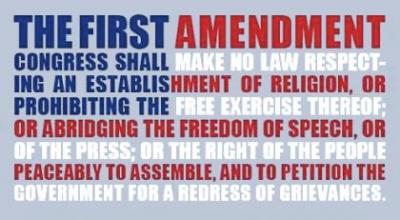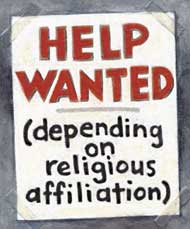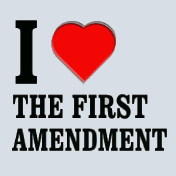 First Amendment, controversial basis of US church-state separation
First Amendment, controversial basis of US church-state separation
Separation of church (or mosque) and state is a national tradition in the US, France and Turkey. The separation was achieved by the American First Amendment, the French Law of 1905 and the 1961 Turkish Constitution. The earliest of these, the First Amendment, has been defined and redefined by court cases, revealing many different aspects of secularism.
These all mean separation of church and state: the First Amendment, the Law of 1905 and the 1961 Constitution. In each country where church-state separation has been won, secularism is known by the specific national legislation which accomplished this.
♦ In the US it's the 1791 First Amendment, which begins by saying that there shall be “no law respecting the establishment of religion”.
♦ In France it's the Law of 1905 whose Article 2 says: “The Republic does not recognise, remunerate or subsidize any religion.”
♦ And in Turkey it's the second article of the 1961 Constitution: “The Turkish Republic is a nationalistic, democratic, secular and social state, governed by the rule of law, based on human rights....”
What is the “First Amendment” and how can it promote separation of church and state?
The First Amendment, adopted in 1791, was part of the American Bill of Rights which was added to the US Constitution in order to insure its ratification. There had been resistance to approving the Constitution because it failed to protect the basic principles of human liberty. The appended Bill of Rights overcame this objection.
The first part of the Amendment was meant to guarantee religious freedom by combining the “no establishment clause” with the “free exercises clause”:
Congress shall make no law respecting an establishment of religion, or prohibiting the free exercise thereof; or abridging the freedom of speech, or of the press; or the right of the people peaceably to assemble, and to petition the Government for a redress of grievances.
But what exactly does this first part mean? As legal scholar Victor Stone said, the Constitution is not self-executing. Until there are disputes about its meaning and these are settled by the courts, it is largely ignored.
 Court challenge to religion in state schools unpacks the Establishment Clause
Court challenge to religion in state schools unpacks the Establishment Clause
Law professor David Meyer explains that until 1945, the meaning of the Establishment Clause was still basically up for grabs. That was when a parent sued a school board, claiming that the religious instruction in the public schools violated the Establishment Clause of the First Amendment — the principle of separation of church and state in the United States. This case, McCollum v. Board of Education, went all the way up to the US Supreme Court which delivered a landmark ruling on it in 1948.
For the first time the Court gave some clear guidance as to what the “establishment clause” really meant and what practices it forbade. The question was whether the constitutional ban on establishing religion meant that all sects must be treated equally, as Board of Education argued was the case in their schools, or whether it required strict neutrality between belief and unbelief, which was Mrs. McCollum's successful contention. [1]
In the Supreme Court judgement, Justice Hugo Black wrote:
Here not only are the State's tax-supported public school buildings used for the dissemination of religious doctrines. The State also affords sectarian groups an invaluable aid in that it helps to provide pupils for their religious classes through the use of the State's compulsory public school machinery. This is not separation of Church and State. [2]
This decision marked the first time in American history that the Supreme Court had prohibited a religious activity in a public school. In the McCollum ruling, the Supreme Court laid down the first brick in the wall of separation between church and state in public schools. And each subsequent case, such as school prayer, adds – or doesn’t add – another brick to that wall. [3]
“Lemon test” for state funding of religion
A further important Supreme Court decision, Lemon v. Kurtzman, handed down in 1971, also helps define church-state separation in the US. It provides a test against which the “Faith-Based Initiatives” of President George Bush can be measured. In 2004 the President used an executive order to circumvent Congress and establish Offices for “Faith-Based Initiatives” with nearly $20 billion in grants in 10 federal agencies, and inside the White House itself. Legal experts have argued that this violates “the Lemon Test”, which sets three conditions for permissible state aid to a religious body.
First, a statute [or public policy] must have a secular legislative purpose; second, its principal or primary effect must be one that neither advances nor inhibits religion; finally, the statute [or policy] must not foster ‘excessive government entanglement with religion.’ [4]
And the government is limited not only in its dealings with religious bodies. Its treatment of personal expressions of religion is also constrained by important principles. Constitutional lawyer and Baptist minister Oliver Thomas describes how the 1994 Religious Freedom Restoration Act (which he helped to write) strives to find a balance between the religious freedom of the individual and the public good.
The test went like this. If the government placed a “substantial burden” on a person's religiously motivated behavior, the government must show that the burden was (1) in furtherance of a "compelling" interest, such as health and safety, and (2) was the least burdensome means of accomplishing that interest. [5]
Can the Free Exercise of Religion Clause be successfully used to shield paedophiles?
And finally, since the issue of clerical abuse gained national prominence in the US in 2002, the meaning of the First Amendment has also been tested by religious groups trying to avoid legal responsibility for shielding priests who have abused children. They claim that the Free Exercise [of religion] Clause gives them immunity.
Religious institutions have constitutional protections, but they are not above the law. Unfortunately, that has not stopped the Roman Catholic Church and other religious groups from arguing that the First Amendment shields them from civil lawsuits for negligent supervision and retention of employees who sexually abuse children. [7]
Most American state courts have rejected this claim, but three have so far accepted it and turned the First Amendment into a shield for organisational liability for paedophile clergy. In 2012 a a man claiming to have been abused by a trusted parish priest when he was 13 or 14 years old challenged this use of the First Amendment’s separation of church and state and tried to get the Supreme Court to hold the Catholic Church legally accountable. However, the Court refused to hear the case. [7]
 Still no laws against religion-based hiring discrimination
Still no laws against religion-based hiring discrimination
In the US court judgements are not the only way to unpack the meaning of the First Amendment. It can be made explicit through two other methods. The Justice Department's Office of Legal Counsel may issue memoranda which interpret the First Amendment and the president may issue “executive orders” concerning its implementation. Both of these were used under former president George W. Bush to permit state funding to religious groups that only hired their own.
These groups, which euphemistically call it “co-religionist hiring” rather than “religion-based hiring discrimination”, have come out publicly against the introduction of any bills that would end the practice. On the other side, Americans United for the Separation of Church and State deplores their stance. Its executive director the Rev. Barry Lynn called it "disgraceful" that when so many Americans are out of work, "some religious leaders want to deny government-funded job opportunities on the basis of religion." [8]
According to the Rev. Lynn the executive orders that permitted state-funded religion-based hiring discrimination could be reversed by President Obama. However, in the present climate this does not appear politically feasible. Any move to do so would undoubtedly unleash damaging charges of religious persecution.
Legal wordplay permits state-funded conversion attempts
And it's not just executive orders that have widened the scope for state support of religion. Since the 1980s the courts have also played a role. One example is involves the curious legal definition of the word “direct”. Normally it means “having no intervening persons, conditions, or agencies”, as in “direct contact”. Thus in the rest of the world “direct funding” means the handing over of funds from the donor to the recipient without any intermediaries. For instance, the European Union does “indirect funding” by way of “financial intermediaries such as banks, credit institutions or venture capital funds”. [9]
However, in the US a new definition of “direct funding” was needed in order to justify state aid for missionising. The US Government now maintains that it doesn't violate church-state separation because it doesn't “directly” fund religion -- even in the case of programmes designed to win converts. In the US “indirect funding is funding that an organisation receives as the result of the genuine and independent private choice of a beneficiary”. [10]
[Since the 1980s US] legislatures, government agencies and the courts have provided religious organizations with a widening range of regulatory and tax exemptions. And [in the 1990s] religious institutions were also been granted access to public money once denied on constitutional grounds, including historic preservation grants and emergency reconstruction funds.
In 2002, the Supreme Court ruled that public money could be used for religious instruction or indoctrination, but only when the intended beneficiaries made the choice themselves between religious and secular programs — as when parents decide whether to use tuition vouchers at religious schools or secular ones. The court emphasized the difference between such “indirect” financing, in which the money flows through beneficiaries who choose that program, and “direct” funding, where the government chooses the programs that receive money. [11]
In other words, so long as there is some comparable non-religious programme available, it is considered acceptable for taxpayers' funds to go to programmes that frankly aim to convert people.
School vouchers and tax credits now enable state funding for religion in US schools
The historic ruling Supreme Court banning religion classes in state schools has not been overturned, but in 2002 and 2011 it was undermined by new judgements of the Court. These permit state funds to subsidise schools where religious instruction is mandatory and pervasive, through the use of school vouchers and tax credits. By encouraging the withdrawal of many pupils to religious enclaves. these developments threaten the ideal of state-funded schools for all where only evidence-based knowledge is taught. They also threaten the separation of church and state. As Justice Souter said in a dissenting opinion on the school voucher case, “This result violates every objective the establishment clause has ever been thought to serve.” [12]
In addition to the high-profile financing of religious schools there are a raft of religious tax exemptions that are rarely even mentioned. These include exemptions from income tax, real-estate tax and property tax.
Any time a "church," which Congress defines very loosely, sprouts up and buys property, all the taxpaying homeowners and businesses in that community get a property-tax increase to make up the loss. This is yet another slap in the face to the notion of equal protection under the law. [13]
Further reading
Claire Mullally, “Religious Liberty in Public Life”, First Amendment Center. http://archive.firstamendmentcenter.org/rel_liberty/free_exercise/index.aspx
Notes
 * Dr. Robert S. Alley, professor emeritus of humanities at the University of Richmond and author of The Supreme Court on Church and State, quoted in Rob Boston, “Vashti's victory: how a valiant Illinois woman and her family won the first Supreme Court verdict on religion and public schools fifty years ago”, Church and State, 1998-04-01. http://www.thefreelibrary.com/Vashti's+victory%3A+how+a+valiant+Illinois+woman+and+her+family+won+the...-a020504010
* Dr. Robert S. Alley, professor emeritus of humanities at the University of Richmond and author of The Supreme Court on Church and State, quoted in Rob Boston, “Vashti's victory: how a valiant Illinois woman and her family won the first Supreme Court verdict on religion and public schools fifty years ago”, Church and State, 1998-04-01. http://www.thefreelibrary.com/Vashti's+victory%3A+how+a+valiant+Illinois+woman+and+her+family+won+the...-a020504010
1. Douglas Martin, “Vashti McCollum, 93, Plaintiff In a Landmark Religion Suit”, New York Times, 2006-08-26. http://select.nytimes.com/gst/abstract.html?res=F70F10FA3B5A0C758EDDA10894DE404482&scp=1&sq=%22Vashti%20McCollum,%2093,%20Plaintiff%20In%20a%20Landmark%20Religion%20Suit%22.%20&st=cse
2. US Supreme Court Justice Hugo Black quoted in Rob Boston, “Vashti's victory: how a valiant Illinois woman and her family won the first Supreme Court verdict on religion and public schools fifty years ago”, Church and State, 1998-04-01. http://www.thefreelibrary.com/Vashti's+victory%3A+how+a+valiant+Illinois+woman+and+her+family+won+the...-a020504010
3. Americans United for Separation of Church and State, “New Documentary Examines The Importance Of The Supreme Court's First Religion-In-Schools Decision”, Church & State, April 2011. http://www.au.org/media/church-and-state/archives/2011/04/the-lord-is-not-on-trial.html
4. Martha A. Boden, “Compassion Inaction: Why President Bush's Faith-Based Initiatives Violate the Establishment Clause”, Seattle University Law Review, vol 29, no 4 (2006). http://digitalcommons.law.seattleu.edu/sulr/vol29/iss4/6/
5. Oliver Thomas, “Column: Religious rights vs. the public's right”, USA Today, 2012-06-04. http://www.usatoday.com/news/opinion/forum/story/2012-06-03/religious-freedom-restoration-court-congress-test/55363988/1
6. “Clerical Abusers and the First Amendment”, Editorial, New York Times, 2012-03-14. http://www.nytimes.com/2012/03/15/opinion/clerical-abusers-and-the-first-amendment.html
7. “Supreme Court refuses church-state case involving child sex abuse by clergy”, Christian Science Monitor, 2012-03-19. http://www.csmonitor.com/USA/Justice/2012/0319/Supreme-Court-refuses-church-state-case-involving-child-sex-abuse-by-clergy
8. Sarah Posner, “Religious Leaders Pressure Congress To Support Religious Discrimination”, Religion Dispatches, 2010-08-26.
“Faith-Based Debate: Obama Signs Order on Funds for Churches: Executive Order Clarifies Bush-Era Policy, But Critics Say It Doesn't Go Far Enough”, ABC News, 2010-11-18. http://abcnews.go.com/Politics/president-obama-executive-order-faith-based-initiative-church/story?id=12180146
Sarah Posner, “CPCs Hire Christians Only With Federal Funds? Thank Obama”, Religion Dispatches, 2012-04-24.
9. “Quick guide to indirect funding.” http://ec.europa.eu/enterprise/policies/finance/guide-to-funding/indirect-funding/index_en.htm
10. “What is the difference between Indirect Funding and Direct Funding?” http://answers.hhs.gov/questions/3522
11. Diana B. Henriques and Andrew Lehren, “Religion for Captive Audiences, With Taxpayers Footing the Bill”, New York Times, 2006-12-10. http://www.nytimes.com/2006/12/10/business/10faith.html
12. Katherine Stewart, “School vouchers and the religious subversion of church-state separation”, Guardian, 2012-04-23. http://www.guardian.co.uk/commentisfree/cifamerica/2012/apr/23/school-vouchers-religious-subversion
13. James G. Rogers, CPA, “Freedom of religion -- not freedom from tax”, Orlando Sentinel, 2014-01-31
http://www.orlandosentinel.com/news/opinion/os-ed-church-tax-exemption-con-20140130,0,5523533.story








